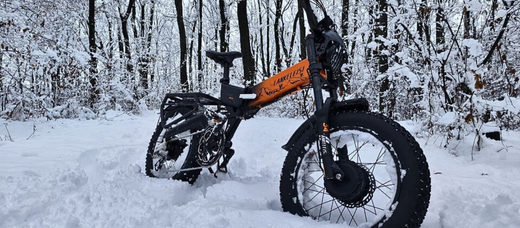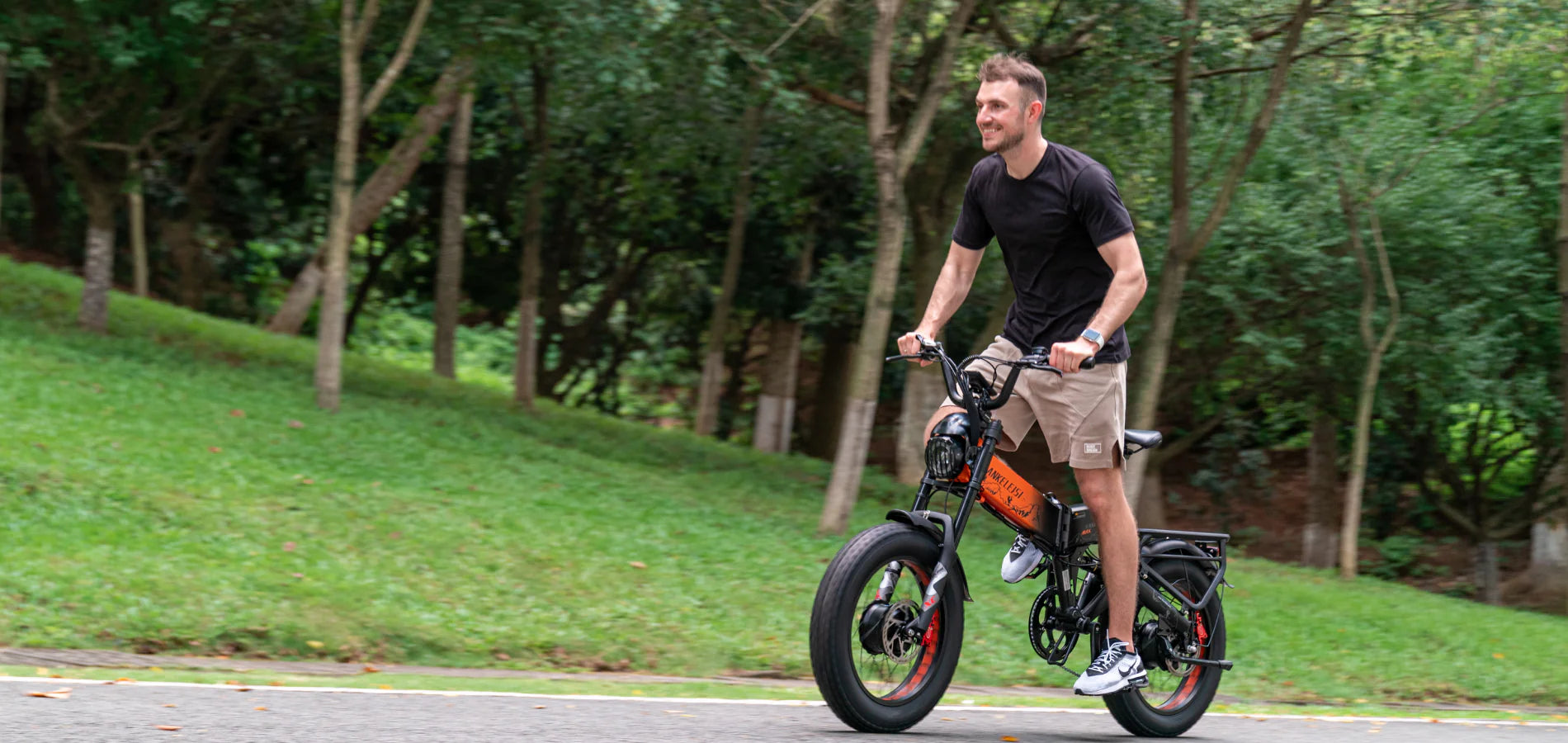A medida que las temperaturas bajan y el invierno se instala en la UE, el clima se vuelve más frío y húmedo, especialmente en diciembre. Las bajas temperaturas, la nieve y las condiciones de congelación a menudo impiden que los ciclistas utilicen sus bicicletas eléctricas, lo que provoca que permanezcan inactivas durante este tiempo. Si no se almacenan correctamente, el rendimiento y la vida útil de la batería pueden verse comprometidos. Por lo tanto, el almacenamiento y mantenimiento adecuados son esenciales. El equipo técnico de Lankeleisi ofrece consejos prácticos sobre cómo almacenar correctamente su bicicleta eléctrica y proteger la batería durante períodos prolongados de inactividad en climas fríos.
¿Por qué los cambios de temperatura afectan el rendimiento de las baterías?
Las bicicletas eléctricas Lankeleisi utilizan baterías de litio. Cuando llega el invierno, el electrolito dentro de la batería se vuelve viscoso, reduciendo la actividad de las sustancias dentro de la batería. La reacción electroquímica se ralentiza, la resistencia interna aumenta y la capacidad de la batería disminuye drásticamente. Cuando la temperatura baja a 0 ℃, la capacidad de la batería será solo del 60% de la de verano.
Cuanto más baja sea la temperatura, menor será la capacidad de la batería. Y en invierno, las bajas temperaturas no solo afectarán la capacidad de la batería, sino también la eficiencia de la carga de la batería. Lankeleisi sugiere que no cargues la batería después de que esté completamente agotada, ya que esto puede llevar a que la batería no se cargue correctamente a bajas temperaturas. Recomendamos que cargues la batería en interiores a 20-25 °C para asegurarte de que la batería se cargue correctamente.
Así que si estás a punto de dejar de montar durante un período prolongado en invierno, lankeleisi sugiere que tomes medidas efectivas para proteger la batería de tu e-bike.
¿Cómo almacenar una bicicleta eléctrica que no se utilizará durante mucho tiempo?
Dónde almacenas tu e-bike es crucial, tanto en invierno como durante todo el año. El entorno de almacenamiento adecuado evitará daños a la batería y extenderá la vida útil de la e-bike. Nuestros técnicos sugieren almacenar la e-bike en un ambiente seco y ventilado, evitando la humedad y la luz solar directa, y almacenar la batería a una temperatura de 20-25°C. Esto evita que la batería entre en crioprotección, lo que impide que la batería se cargue correctamente.
EVITAR LA LUZ SOLAR DIRECTA: La batería y el marco de la bicicleta eléctrica no son adecuados para estar expuestos a la luz solar durante mucho tiempo. La alta temperatura del sol acelerará el envejecimiento de la batería y puede incluso causar que se sobrecaliente, afectando su rendimiento y seguridad.
EVITAR AMBIENTE HÚMEDO: Los entornos húmedos pueden provocar fácilmente un cortocircuito de la batería y dañar los componentes eléctricos, así que al almacenar tu e-bike, asegúrate de que esté en un área seca y ventilada.
CONSEJO CALIENTE: Si te encuentras en un área más fría, asegúrate de que la bicicleta no esté expuesta a temperaturas excesivamente bajas mientras está almacenada. Aunque la mayoría de las baterías de bicicletas eléctricas son resistentes a bajas temperaturas, las temperaturas extremadamente bajas pueden afectar el rendimiento de la batería, y es mejor almacenar tu bicicleta eléctrica en un lugar cálido (en un ambiente de 20°C - 25°C).
¿Cómo proteger la batería cuando no se utiliza la e-bike durante mucho tiempo?
1. Carga la batería una vez a la semana.
El invierno es la temporada en la que las baterías de las bicicletas eléctricas son más propensas a deteriorarse, especialmente si no montas durante un período prolongado. Si planeas almacenar tu bicicleta eléctrica durante aproximadamente tres meses en invierno, deberías cargarla al menos 12 veces. Cargarla una vez a la semana ayudará a activar la batería y prevenir el envejecimiento o la degradación debido a largos períodos sin carga. Simplemente carga la batería al 70% cada vez.
2. Descarga la batería regularmente (también una vez a la semana)
Incluso si no usas tu bicicleta eléctrica durante mucho tiempo en invierno, aún necesitas hacerle una descarga profunda regularmente. Se recomienda hacerlo una vez a la semana, lo que activará la batería y asegurará que las sustancias de activación de la batería estén activas, lo que es más útil para prolongar la vida útil de la batería y evitar la sulfatación de la batería.
¿Cómo descargar profundamente la batería sin montar en la e-bike? Puedes usar el caballete de la bicicleta, inclinar la bicicleta de modo que la rueda trasera de la bicicleta quede suspendida, encender el medidor y usar el acelerador para hacer girar la rueda trasera y consumir la energía de la batería. Esta es una forma simple y efectiva de ayudar a mantener la batería activa. Recuerda no sobrecargar la batería para evitar drenarla completamente y hacer que sea imposible recargarla.
Manteniendo la batería correctamente nivelada
Cargar y descargar regularmente la batería una vez a la semana y mantener el nivel de la batería entre el 40% y el 60% ayuda a evitar la sobredescarga y la sobrecarga, reduciendo la degradación debido a las bajas temperaturas. Además, esta operación asegura que la batería permanezca activa durante el almacenamiento a largo plazo, previniendo el envejecimiento o la desactivación de los químicos internos de la batería y extendiendo significativamente la vida y estabilidad de la batería.
Revisa la batería regularmente
Revisar regularmente la batería de su e-bike ayudará a garantizar su seguridad, rendimiento y longevidad. Al revisar, puede prestar atención a la apariencia de la batería, si hay daños evidentes o hinchazón, si el puerto de descarga de la batería está suelto, si la carga de la batería es normal o no, y si la batería tiene problemas de fuga. A través de una inspección regular, se pueden detectar problemas a tiempo; si su batería presenta los problemas mencionados, puede enviar el problema a nuestro personal de postventa de inmediato, los técnicos de lankeleisi le darán consejos profesionales para ayudarle a resolver el problema, podrá evitar las molestias de montar y los peligros de seguridad que conlleva un problema de batería.
Conclusión
En el frío invierno, la batería de la bicicleta eléctrica es fácil de recibir la influencia de las bajas temperaturas y el inactividad prolongada, lo que puede causar que el rendimiento de la batería decline o envejezca prematuramente, afectando la vida útil de la batería. Para proteger eficazmente la batería y prolongar su vida útil, se recomienda almacenar la batería en un ambiente seco y cálido (preferiblemente entre 20℃-25℃), y cargar y descargar la batería regularmente, se recomienda una vez a la semana, para mantener la energía de la batería entre el 40% y el 60%.
Además, revisa regularmente la apariencia y las conexiones de la batería para mantener un control sobre la seguridad de la batería. Siguiendo estos pasos simples y efectivos, puedes asegurarte de que la batería de tu bicicleta eléctrica Lankeleisi funcione bien durante el invierno y esté lista para nuevas aventuras de conducción cuando las temperaturas vuelvan a subir.








